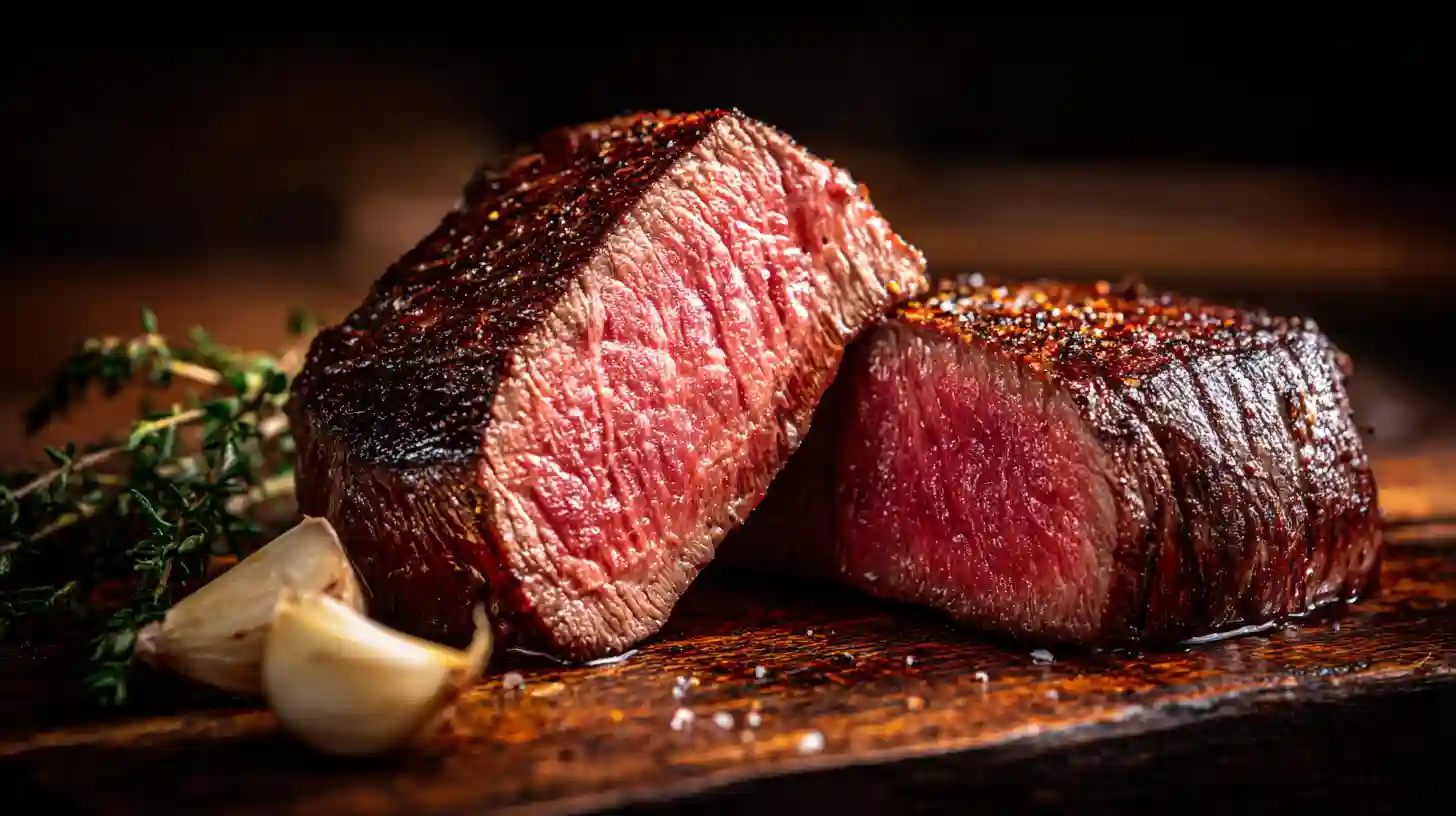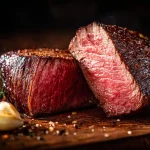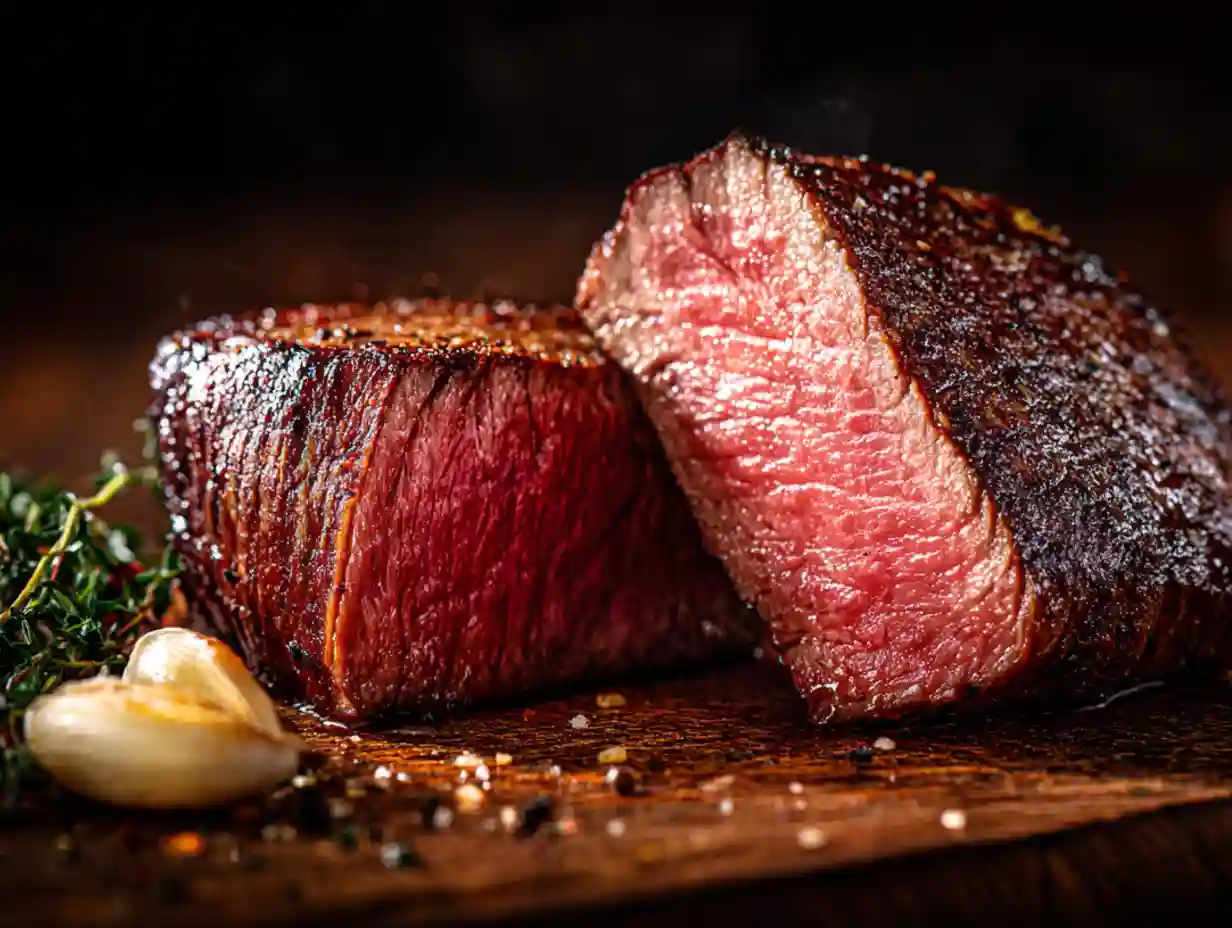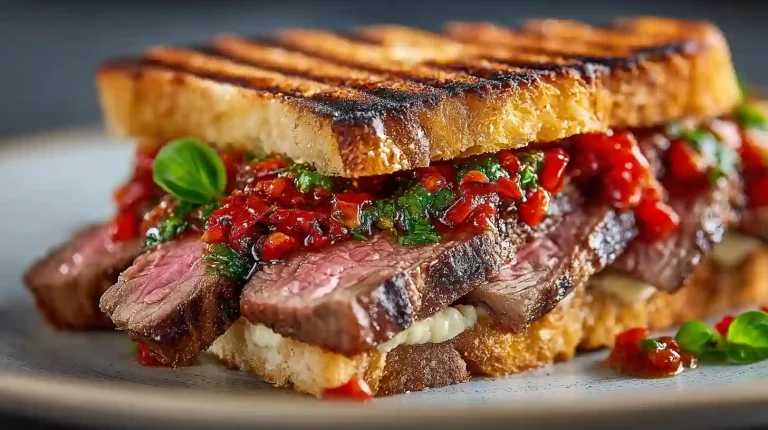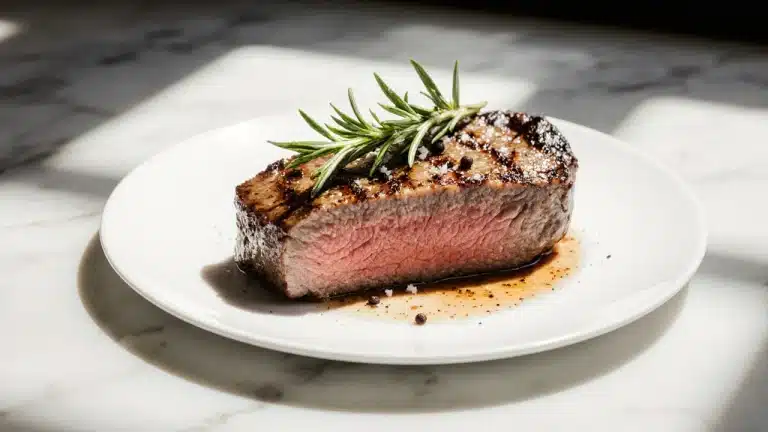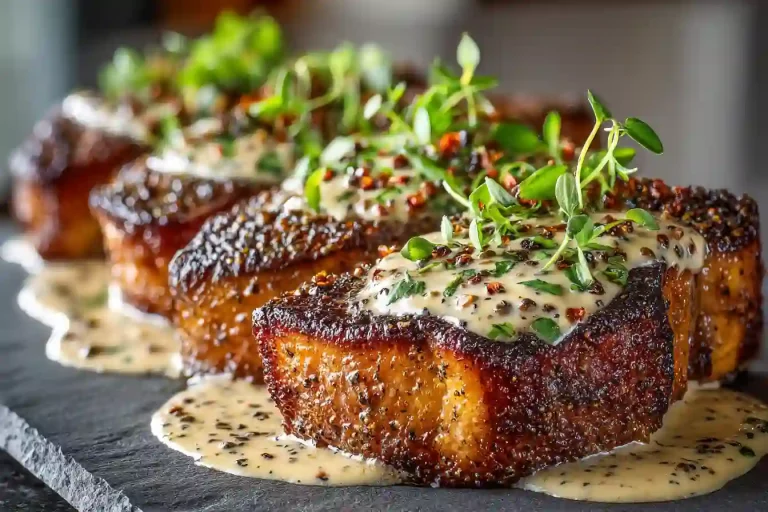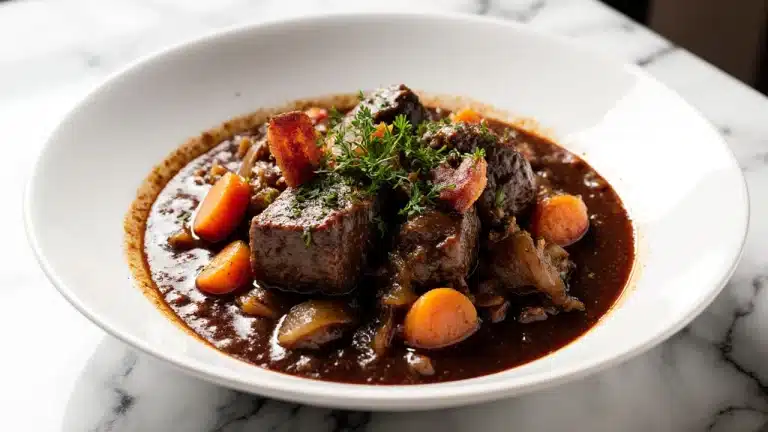Gordon Ramsay Filet Mignon: Never Overcook Steak Again (The #1 Method)
Cooking a Gordon Ramsay filet mignon is a high-stakes test of a home cook’s nerve. You have a beautiful, expensive piece of beef, and the line between a perfect medium-rare and a dry, grey, overcooked tragedy is brutally thin. For years, I was terrified. I followed vague recipes that told me to cook for “4-5 minutes per side,” and the results were inconsistent at best. I was guessing, and with a cut this prized, guessing is a recipe for disaster.
I’m Marcus Reed. I got tired of the fear. I went back to the source—every TV show, every furious rant, every masterclass—and I realized the truth. A perfect Gordon Ramsay filet mignon is not the result of guesswork; it’s the result of a foolproof, end-to-end system. I’ve decoded that system: from the critical tempering of the meat before the pan is even on the stove, to the science of the aromatic butter baste, to the non-negotiable resting period. This is the blueprint that removes fear and guarantees a perfect result.
The Method: The Foolproof Filet Mignon System
An authentic Gordon Ramsay filet mignon is all about controlling temperature and building layers of flavor. Each step is a deliberate part of a system designed to produce two things: a deep, dark, flavorful crust and a perfectly pink, tender, wall-to-wall medium-rare center.
- The Tempering (The First Law): This is the most overlooked step. You must never cook a steak straight from the fridge. A cold steak will cook unevenly, resulting in a burnt exterior before the center is cooked. You must take your Gordon Ramsay filet mignon out of the fridge at least 20 minutes before cooking to let it come to room temperature. This ensures a perfectly even cook from edge to center.
- The Sear (The Flavor Crust): The pan must be screaming hot. “No color, no flavor,” as Ramsay says. You need a high-quality, heavy-bottomed pan and a high-smoke-point oil. The goal is to create a deep, dark, caramelized crust as quickly as possible on all sides—including the edges, which you can sear by rolling the steak with tongs. This hard sear is the foundation of the flavor for your Gordon Ramsay filet mignon.
- The Aromatic Butter Baste (The Flavor Infusion): This is the technique that separates a good steak from a great one. Once the steak is seared, you lower the heat and add a generous knob of butter. But you don’t just melt it. You add crushed garlic cloves and hardy herbs like thyme and rosemary to the pan. As the butter foams, you continuously tilt the pan and spoon this fragrant, bubbling, infused fat over the top of the steak. This gently cooks the steak with an aromatic, nutty-brown butter, building an incredible layer of flavor. A perfect Gordon Ramsay filet mignon is always basted.
- The Rest (The Non-Negotiable Law of Juiciness): This is the most critical and most violated law of steak cookery. When you take the steak off the heat, the muscle fibers are tense. If you slice into it immediately, all the beautiful juices will flood onto the cutting board, leaving you with a dry steak. You must let it rest for at least 10 minutes. During this time, the fibers relax and reabsorb those juices, ensuring every bite is succulent and flavorful.
Mistake Watchouts: I Made a Grey Steak So You Don’t Have To
My first attempt at a true Gordon Ramsay filet mignon was a failure of confidence. I was scared of the heat, I was scared of undercooking it, and I was impatient. The result was a steak with a pale, sad sear and a thick, grey band of overcooked meat just under the surface. It was a waste of a beautiful cut. Here’s what I learned.
- The Mistake: I Cooked a Cold Steak. I took the filet straight from the fridge to the pan. The outside browned too quickly while the inside was still ice cold. I had to leave it in the pan longer to cook the center, which resulted in that dreaded overcooked grey band.
- The Fix: Temper your meat. Letting your Gordon Ramsay filet mignon sit on the counter for 20 minutes is not optional. It is essential for an even cook.
- The Mistake: I Was Scared of the Heat. I used a medium-high heat because I was afraid of burning the steak. The result was a weak, light-brown sear that lacked any deep, rich flavor.
- The Fix: Be brave. Use a cast-iron or carbon steel pan and get it screaming hot. You want an aggressive, confident sizzle the moment the steak hits the pan. A proper Gordon Ramsay filet mignon demands high heat.
- The Mistake: I Was Impatient and Didn’t Rest It. I was hungry. I pulled the steak from the pan and sliced it open after only a minute. A pool of expensive juice immediately flooded my cutting board. The steak itself was disappointingly dry.
- The Fix: Rest your steak. For a thick Gordon Ramsay filet mignon, a 10-minute rest is the minimum. It is the most important step for a juicy result.
The Recipe: Gordon Ramsay’s Perfect Filet Mignon
Gordon Ramsay’s Perfect Filet Mignon
Ingredients
Equipment
Method
- Temper the Meat: Remove the filet mignon from the fridge 20 minutes before cooking to allow it to come to room temperature. This is a critical step for an even cook.
- Season Generously: Pat the steaks completely dry with a paper towel. Season all sides very generously with coarse sea salt and freshly cracked black pepper. Press the seasoning into the meat.
- Sear the Steak: Get a heavy-bottomed skillet screaming hot over high heat. Add the oil. Carefully place the steaks in the hot pan. Sear for 2 minutes without moving them to build a deep brown crust. Flip and sear the other side for 2 minutes.
- Sear the Edges: Using tongs, turn the steaks on their sides and sear the edges for about 30 seconds each until a crust has formed all the way around.
- Baste with Butter: Reduce the heat to medium. Add the butter, smashed garlic, and thyme/rosemary sprigs to the pan. Once the butter is melted and foaming, tilt the pan towards you and continuously spoon the fragrant, bubbling butter over the steaks for 1-2 minutes.
- Check Temperature: For a perfect medium-rare, check the internal temperature with a digital thermometer. You want to pull the steak from the pan when it reaches 125°F / 52°C.
- REST THE STEAK: This is a non-negotiable step. Remove the steak from the pan and place it on a cutting board. Let it rest for a full 10 minutes. Do not slice it.
- Slice and Serve: After resting, slice the steak against the grain into thick medallions and serve immediately.
Nutrition
Notes
Love this recipe?
Give us 5 stars and comment!The Execution: Step-by-Step
- Prep: Take the filet mignon out of the fridge 20 minutes before cooking. Pat it completely dry with a paper towel and season all sides generously with coarse salt and freshly cracked black pepper.
- Sear: Get a heavy-bottomed skillet screaming hot over high heat. Add a tablespoon of a high-smoke-point oil (like grapeseed or canola). Carefully place the steak in the pan. Sear for 2-3 minutes per side until a deep, dark crust forms.
- Sear the Edges: Using tongs, turn the steak on its side and roll the edges in the pan for about 30 seconds each to render the fat and create a crust all the way around.
- Baste: Reduce the heat to medium. Add the butter, smashed garlic cloves, and thyme/rosemary sprigs to the pan. As the butter foams, tilt the pan and continuously spoon the fragrant, bubbling butter over the steak for 1-2 minutes. For a perfect medium-rare, the internal temperature should be 125°F (52°C).
- Rest: Remove the steak from the pan and place it on a cutting board. Let it rest for a full 10 minutes. Do not slice it. Do not touch it.
- Serve: After resting, slice the steak against the grain into thick pieces. Serve immediately.
Sanctioned Riffs (Variations That Respect the Method)
The core four-stage system for a Gordon Ramsay filet mignon is sacred. However, you can make minor additions. For an extra layer of flavor, you can brush the steak with a touch of Dijon mustard before seasoning. You can also use shallots instead of garlic in the butter baste for a milder, sweeter aromatic. The key is that the tempering, searing, basting, and resting method must not be compromised.
Plating and Execution
A perfectly cooked Gordon Ramsay filet mignon is a work of art and should be presented simply. Slice it into thick, 1/2-inch medallions and fan them out on the plate to showcase the perfect, wall-to-wall pink center. Spoon some of the aromatic pan juices from the resting board over the top. Serve it with a simple side, like creamy mashed potatoes or roasted asparagus, that won’t overshadow the steak.
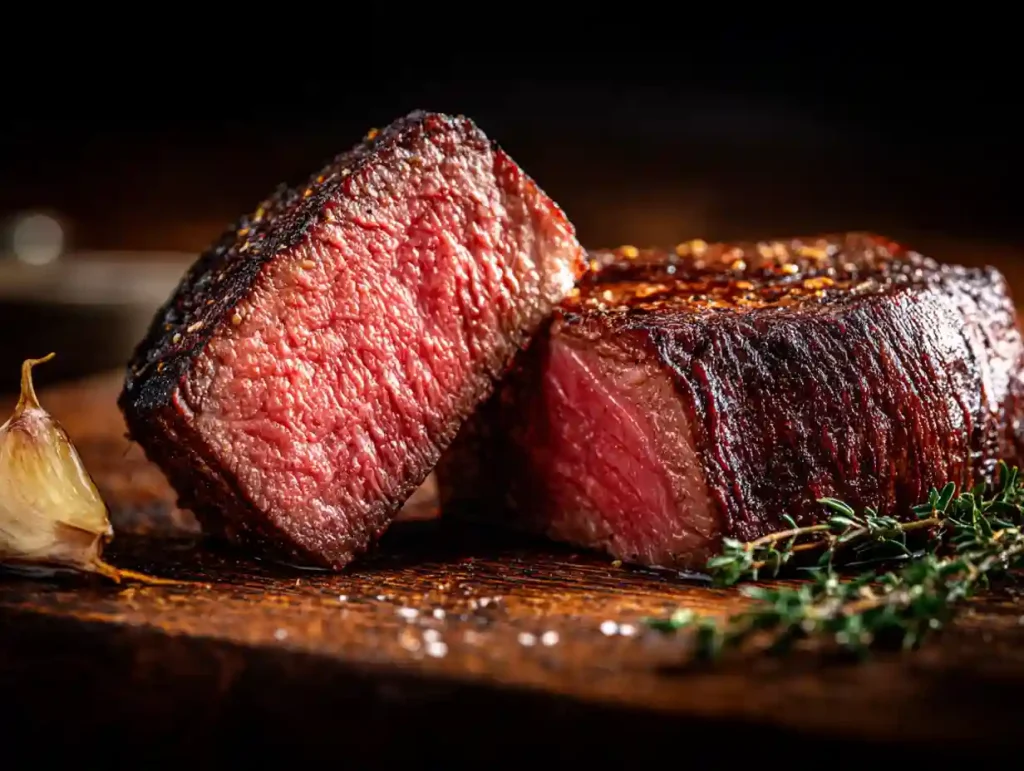
Recipe FAQs
How do I know when my Gordon Ramsay filet mignon is medium-rare?
While you can use timing as a guide, the only foolproof way is with a digital meat thermometer. For a perfect medium-rare, you should pull the steak from the pan when the internal temperature reaches 125°F or 52°C. The temperature will continue to rise by a few degrees as it rests.
Why did my steak have a thick grey band around the edge?
This is a classic sign of cooking a cold steak. If the steak is cold in the center, you have to leave it on the heat for longer to cook through, which overcooks the exterior. Tempering your Gordon Ramsay filet mignon for 20 minutes at room temperature is the only way to prevent this and achieve a perfect wall-to-wall pink.
Is resting the steak really that important?
Yes. It is arguably the most important step in the entire process. A 10-minute rest allows the muscle fibers to relax and reabsorb the juices, guaranteeing a tender and succulent steak. Slicing a Gordon Ramsay filet mignon too early will ruin the texture and flavor you worked so hard to build.
The Result & Conclusion
When you slice into it, you’ll see the proof. The crust is a deep, dark, salty, and caramelized counterpoint to the impossibly tender, wall-to-wall pink interior. Each bite is incredibly juicy and infused with the rich, nutty flavor of the brown butter and the subtle aroma of garlic and herbs. You haven’t just cooked a piece of meat. You have executed a professional, foolproof system from start to finish. You have mastered the perfect Gordon Ramsay filet mignon.
Your Turn. Get to Work.
You’ve mastered the king of steaks by focusing on a system of precision and control. Now, apply that same philosophy to other legendary red meat dishes. Continue your education with the definitive guide to Gordon Ramsay’s Beef & Lamb Recipes.

